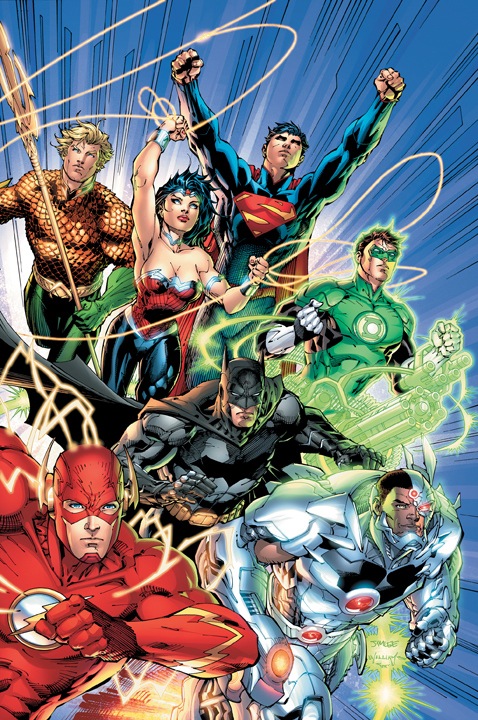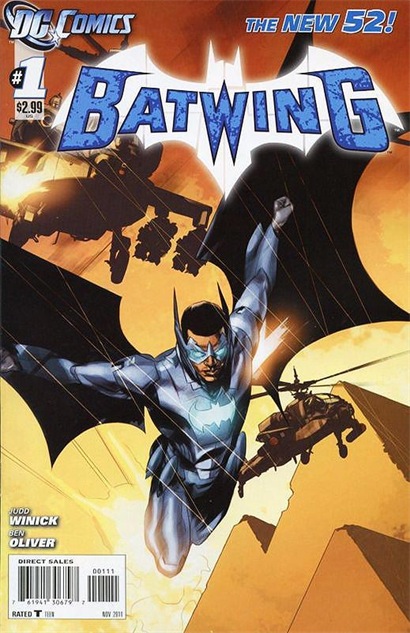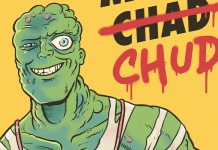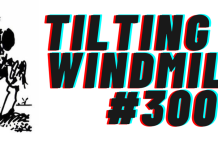
With Convergence, aka Atlas Moving Vans, now rolling out in the DCU and the New 24 about to launch, several websites have taken a look back at The New 52, which launched in September of 2011 and super-charged the comics industry. As I’ve written several times before, the pr for the New 52 immediately lifted the entire comics industry with more customers coming into stores and finding a lot of new comics to read. Call it the Millennial Rush. The debut of Saga #1 six months later hooked those who were just nibbling and he rest is history: record breaking sales.
While the New 52 was a commercial success, the books themselves were a mixed bag. The entire initiative was put together so quickly that a lot of books ended up being “beauty pageants” where several writers pitched at the same time, and some of them even thought they had the gig until the very last second. People were butthurt right from the gitgo. While the number of books — yes, 52 — remained steady for quite a while, the creative teams soon started resembling a game of beach blanket bingo, people came and went with revolving door frequency and sales generally stayed on a “general attrition” trajectory.
But there’s no denying that the New 52 was the most successful and audacious launch of the “modern” comics era…whatever you call that. (Definitions in the comments are welcome.) Or at least since the Ultimate line.
There were 68 titles; 20 of them lasted all 40 issues; 12 of them will make it past Convergence. (Titles with an asterisk are the ones moving on to the Nü DC:) Action Comics*, Aquaman*, Batgirl*, Batman*, Batman and Robin, Batwoman, Birds of Prey, Catwoman*, Detective Comics*, The Flash*, Green Arrow*, Green Lantern*, Justice League*, Red Hood and the Outlaws, Red Lanterns, Suicide Squad, Supergirl, Superman,* Swamp Thing, Wonder Woman*.
As you can see the titles that made it are the titles you’d expect in the core DC line. Surely no one expected to see Red Hood and the Outlaws make it to the 52 finish line, but then the New 52 saw many strange things, like the resurgence of Scott Lobdell’s writing career, a brief resurgence for Rob Liefeld’s writing career, and scores of foreign artists with hard to spell names filling in all over the place.
A couple of sites have more in depth looks at the legacy. Steve Foxe at Paste magazine has a Talking Dead-style In Loving Memory: All 68 DC Comics That Have Come and Gone Within the New 52 slideshow with EVERY WRITER AND ARTIST that worked on the books. God bless.
The New 52, for all of its initial commercial success, has often had a rocky relationship with critics as well as longtime fans up in arms over changes to decades-old characters. Nearly four years after its debut, DC is using its cross-country corporate move to Burbank, California as an opportunity to officially end the New 52 banner and do another reshuffling, wrapping up all but 25 of its current ongoing titles and debuting 24 new series in June once the Convergence crossover wraps up.
Kelly Harrass at Panels on Pages has an even more in depth history in two parts, here and here with such bleak notations as the following:
In its 30 issue run, Suicide Squad had 4 writers and 16 artists.
Harass also notes:
In this climate, it’s hard to look at the fact that only 12 of the original 52 survived and say that there’s anything wrong with that number. It’s not like DC is a failure. Books just get cancelled more often now. I’d be interested to see how many Marvel series that were going when the New 52 started are still running. We’re just seeing shorter volumes these days.
Which is a good equalizer. The bottom line on the new 52 will be for history to judge, but it will be no surprise to say that the books that were the best has the most steady art teams—Batman and Wonder Woman most notably. There may have been laughable moments and questionable editorial decisions, but for many new comics readers, The New 52 will forever be what got them hooked. Its legacy will live on.










Having tussled a lot while at CBG with the challenges of defining of eras based on creative content, at my own site I define the most recent era including as released in April 1997 or later, or during the Diamond Exclusive Era. That’s when Marvel shuttered Heroes World; beginning then, the numbers we see from Diamond are more or less representative of the Direct Market’s numbers as a whole. It’s sort of like going by the 162-game season in baseball; it’s a standardizing measure.
“Modern” I would actually reserve for the whole Direct Market era, though there is no clean start to it as there is with the Diamond era. This I would liken to the live-ball era in baseball, starting in 1920; when you compare stats before and after, you’re really dealing with a different game. So it is with the newsstand and direct market eras in comics.
If I were naming the ages of the hero-comics industry, I’d go with Platinum, Golden, Silver, Bronze, Chromium, and now entering Silicon. The Chromium Age refers to the rise of the Direct Market and its collectible covers (roughly the mid 1980s thru the noughties), with the advent of digital distribution as an important channel defining the Silicon Age.
(The obsessive in me would prefer to replace Bronze with Copper, because bronze is an alloy not an element, but Bronze is too well established.)
As you may know, I like to call the Aughties the “Crisis Era.”
“In its 30 issue run, Suicide Squad had 4 writers and 16 artists.”
Musical chairs was the norm in the ’70s, when writers and artists rarely lasted more than a few issues on most titles. The Black Widow feature in “Amazing Adventures” (1970-71) lasted only eight issues, but had four writers (Gary Friedrich, Mimi Gold, Roy Thomas and Gerry Conway) and three artists (John Buscema, Gene Colan and Don Heck).
The longevity of Wolfman and Colan on “Tomb of Dracula” was a rarity in the ’70s. Maybe that sort of commitment is becoming rare again.
Here’s an interesting article: “Crisis Management: Why DC Comics is always changing everything.”
http://kotaku.com/crisis-management-why-dc-comics-is-always-changing-eve-1684714600
The only New 52 launch titles I really glommed onto were Batman, Wonder Woman, Frankenstein: Agent of SHADE (which I dearly miss), The Flash, and Batwoman.
I’ve shed them all, except Batman, only because their launch teams left. Now my DC pull is: Multiversity, Sandman: Overture (when it comes out, and yeah Vertigo, I know), Gotham Academy, Batgirl, and Batman.
I’m still undecided on what I’ll jump into post-Convergence. Black Canary for sure…unsure about the rest.
One thing is clear from Steve Foxe’s slideshow: DC’s attempt to revive western, war, horror and sword & sorcery comics was a failure. The Big Two only know how to sell superheroes these days, and that’s all their core audience wants. Archie has a more interesting and diverse (and, oddly, more adult) lineup than DC or Marvel these days.
The Original DC Characters are eagerly fascinating. The New 52 has rebooted since 2011, so the whole legend in the DC Universe stays the same through the ages.
The problem with the Golden Age and Silver Age is that they were coined in reference to superhero comics specifically, and don’t make as much sense when trying to discuss comics as a whole. For example, it’d make more sense for the Silver Age to start with the creation of the Comics Code than with the introduction of a new Flash in Showcase.
But if we’re focusing just on superhero comics, then based on where the Golden and Silver Ages start, I’d break the rest down like this:
1938 – Golden Age Of Superhero Comics
Superman debuts, the first superhero.
1956 – Silver Age Of Superhero Comics
Flash is the first superhero to be modernized/reimagined for the times.
1970 – Bronze Age Of Superhero Comics
The series Green Lantern/Green Arrow introduces superheroes to social issues.
1985 – Dark Age Of Superhero Comics
Marvelman, Watchman, The Dark Knight Returns, The Killing Joke reimagine and deconstruct superheroes in darker light, such as switching gears from tying up damsels to sexually assaulting or murdering them.
2000 – Modern Age Of Superhero Comics
Ultimate Spider-Man, Powers, and The Authority (and to a lesser extent Rising Stars and Sam & Twitch) usher in an era of writer-driven, decompressed, “widescreen” superhero comics written in distinct arcs. (The Authority crumbles in the era of post-9/11 superheroes.)
201? – ? Age Of Superhero Comics
Note that the average Superhero Age lasts around 15 years. We’re already closing in on a new era, experiencing the early growing pains related to greater diversity and social awareness. What books or heroes will define this period?
Excellent post. It wasn’t all bad, but I’m glad to see the New 52 era give way to what will hopefully be a time when DC embraces the changing market demographics.
Don’t be surprise that Red Hood and The Outlaws lasted all the way. It was leaps and bounds the best series in the New 52.
Merging the Wildstorm books into the main DC universe was far and away the biggest mistake of the New 52. Those characters lost all of their unique identity and are a shell of their former incarnations.
The second biggest mistake of the New 52 was undoing the original Crisis and separating the Earth 2 characters onto a different continuity. This reboot could have been a chance to finally cement those characters into the main DC universe legacy.
Sadly the very simple solution to both of these problems would have been to just have these 2 groups of characters swap places with the Earth 2 characters on the main New 52 Earth and the Wildstorm characters featured in 1-2 books with limited interaction with The New 52.
I had collected comics as a kid, then life happened (job, wife, kids, grad school) and my time and money waned. I always looked for a good jumping-on point, and when the New 52 was announced, I found my spot. In August 2011 I was right there getting the new #1s and have been a regular Wednesday comic shopper ever since. Since getting into the shops, I discovered many new comics I didn’t know existed, created (what feels like) relationships with authors and artists (Love Epting and Hitch, hate Quietly) and grown to have a ridiculous amount of comics I get weekly, with now only about half being DC/Marvel. So in that fashion, the New 52 worked for everyone. As actual comics, though, it was hit and miss.
I’ve always been a Green Lantern fan, but I have not enjoyed hardly anything they have done with GLs in the N52. They are either turning traitor, losing their powers, or turning on each other.
Seems like every other day someone was dying, coming out of the closet, getting a new costume, or devoting their book to a crossover event. Got tiring.
Loved Frankenstein’s book, though. More SHADE please.
Birds of Prey did not last 40 issues.
Call it the Ephemeral Age.
Publishers think it is a big deal to squeeze 40 issues out of a book. Writers and artists vanish from month to month. Customers buy and read ‘books’ they can’t actually hold. Collections are kept on the Cloud.
Continuing my previous post,
The N52 had many good things. Great art throughout, high quality physical books (paper, covers), lots of variants, and the return of many characters we love. What was continually frustrating was the endless crossovers which ended up meaning nothing—the status quo always ended up coming back at the end. Who cares about a 10 book event if things are the same as before once it ends? Most books felt like a stretched out version of a story—nothing more than an advertisement for next month’s book. Less and less happen only to end with a cliffhanger–all to keep you buying more books. Worked on me, week after week. Still does. Frustrating, though.
“In its 30 issue run, Suicide Squad had 4 writers and 16 artists”
No, like most of the series in The new 52, the series had one writer: DC Editorial. Doesn’t matter whose name you put at the top…
Sorry guys. Sales and market are at the lowest they’ve been in the last five years. The erasure of 70 years of history netted the company a whopping 5% new readership while alienating the bulk it’s older readers who had actually been solid costumers for years.
There were a few high area – Aquaman has gotten very good reviews – but the middle way will be the saving grace here. Some old, some new. New fans need to learn to share the books and old fans have been more then loyal enough to have earned not the be left behind.
I will also say that this would be an incredible time to add some new characters – and diversity with them. I can honestly say I love new characters. It’s a thing for me. But I want real Ollie back first – not Green Batman. And that’ll be with a side of Dinah, not Felicity. Not everything has to be the TV show.
“I’d be interested to see how many Marvel series that were going when the New 52 started are still running.”
-Avengers
– New Avengers
Daredevil
-Deadpool
-Thor (rebooted for the character, serie still there)
-Wolverine & the X-Men (rebooted serie still there)
-All New X-Men
-Uncanny Avengers
-Nova
-Captain America
– Spider-Man (rebooted, same character)
-Hulk (rebooted, same character)
– Iron Man (rebooted same character)
-Secret Avengers
– Avengers World
The new created
– Ms Marvel
-Spider-Gwen
-Guardians of the Galaxy
– X-Men
And many I can’t even remember.
I’d love to know where the author of the article got his statistics for New 52’s “commercial success.”
In February, an IDW comic book outsold DC’s top title by a margin of 4-to-1. In March, 9 out of the top 10 comics sold were Marvels, and DC had only 3 titles in the Top 20.
Any more commercial success like that, and they are undone.
(sigh)
@Airea and Kevin Tuma – actually DC’s total sales to the direct market year over year are still higher than they were prior to the reboot. Individual books are not a sign of anything. Plus, who says that 5 years of increased sales aren’t sufficient for the reboot to have been worth it?
February update:
DC Sales – Top 300 (Jan-Feb) 2015 – 3,866,771 estimated units.
DC Sales – Top 300 (Jan-Feb) 2014 – 3,740,813 estimated units.
And here are the figures for 1997-2014:
2014 – 26,836,455 estimated units
2013 – 28,184,085 estimated units
2012 – 29,602,125 estimated units
2011 – 26,522,201 estimated units
2010 – 23,528,000 estimated units
http://community.comicbookresources.com/showthread.php?2355-DC-Sales-amp-Estimates-Discussion/page30&highlight=sales
As for how many series Marvel still has running since the new52 launched, the answer is Zero. All of the series that were running that month ended, or were cancelled. They may have relaunched, but the numbering restarted. Which is more “noble” – ending a series that just isn’t working to devote resources to other places, or just tricking people into thinking something is new when it’s really just the same series from before with a new number on the front?
DC sales inside the Top300 March 2011(pre-New52): +2m units
DC sales inside the Top300 March 2015(post-Nu52): 1.85m units
Dollar gross on both months: round $9.6m which means that despite the much higher prices in 2015 DC actually lost money cause production costs are now much higher compared to 5 years ago. And all that when DC floods the market with an unbelievable numbers of books each month(in January they published 38(!!!)% more books than Marvel) and has all kinds of variants covers on the majority of the DCU titles, something they did not have 5 years ago. Anybody still claiming the New52 is a “success”?
@deep_shock Yes, I most certainly do. Sales go up and down over the course of a year. Why do you think comparing two individual months is any sort of practical measure? Year over year, as I mentioned, is more accurate. And it doesn’t do any good to flood the market if nobody wants to buy your books, which obviously people have. And ill need you to link to a source that shows that production costs have gone up significantly since 2011.
Bring back the overshorts.
“There were 68 titles; 20 of them lasted all 40 issues”
What about Justice League Dark?
Can anything be considered a success in a industry that makes less in a year than what one Super-Hero movie can make in a few months. Comics are great as a art forum. But its a dying industry. And the constant use of gimmicks and events that both Marvel and DC have been using for decades is not going to save it.
Comments are closed.